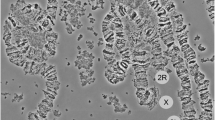Abstract
The epidemiology of malaria in Africa is complicated by the fact that its principal vector, the mosquito Anopheles gambiae, constitutes a complex of six sibling species. Each species is characterized by a unique array of paracentric inversions, as deduced by karyotypic analysis. In addition, most of the species carry a number of polymorphic inversions. In order to develop an understanding of the evolutionary histories of different parts of the genome, we compared the genetic variation of areas inside and outside inversions in two distinct inversion karyotypes of A. gambiae. Thirty-five cDNA clones were mapped on the five arms of the A. gambiae chromosomes with divisional probes. Sixteen of these clones, localized both inside and outside inversions of chromosome 2, were used as probes in order to determine the nucleotide diversity of different parts of the genome in the two inversion karyotypes. We observed that the sequence diversity inside the inversion is more than threefold lower than in areas outside the inversion and that the degree of divergence increases gradually at loci at increasing distance from the inversion. To interpret the data we present a selectionist and a stochastic model, both of which point to a relatively recent origin of the studied inversion and may suggest differences between the evolutionary history of inversions in Anopheles and Drosophila species.
Similar content being viewed by others
References
Aquadro CF, Weaver AL, Schaeffer SW, Anderson WW (1991) Molecular evolution of inversions in Drosophila pseudoobscura: the amylase gene region. Proc Natl Acad Sci USA 88:305–309
Ashburner M (1989a) In: Drosophila: a laboratory manual. Cold Spring Harbor Laboratories, Cold Spring Harbor, New York
Ashbumer M (1989b) In: Drosophila: a laboratory handbook. Cold Spring Harbor Laboratories, Cold Spring Harbor, New York
Begun DJ, Aquadro CF (1992) Levels of naturally occuring DNA polymorphism correlate with recombination rates in Drosophila melanogaster. Nature 356:519–520
Besansky N, Powell JR (1992) Reassociation kinetics of Anopheles gambiae DNA. J Med Entomol 29:125–128
Charlesworth B (1992) New genes sweep clean. Nature 356:475–476
Coluzzi M (1992) Malaria vector analysis and control. Parasitol Today 8:113–118
Coluzzi M, Kitzmiller JB (1975) Anopheline mosquitoes. In: King RC (ed) Handbook of genetics, vol 3. Plenum, New York, p 285
Coluzzi M, Petrarca V, Di Deco MA (1985) Chromosomal inversion integradation and incipient speciation in Anopheles gambiae. Boll Zool 52:45–63
Coluzzi M, Sabatini A, Petrarca V, Di Deco MA (1979) Chromosomal differentiation and adaptation to human environments in the Anopheles gambiae s.s complex. Trans R Soc Trop Med Hyg 73:483–497
Dobzhansky Th (1970) In: Genetics of the evolutionary process. Columbia University Press, New York
Hedrick PW, Jain S, Holden L (1978) Multilocus systems in evolution. Evol Biol 11:101–182
Kaplan NL, Hudson RR, Langley CH (1989) The “hitchhiking” effect revisited. Genetics 123:887–899
Nei M (1987) In: Molecular evolutionary genetics. Columbia University Press, New York
Powell JR (1991) Monophyly/paraphyly/polyphyly and gene/species trees: an example from Drosophila. Mol Biol Evol 8:892–896
Powell JR (1992) Inversion polymorphisms in Drosophila pseudoobscura and Drosophila persimilis In: Krimbas CB, Powell JR (ededs) Drosophila inversion polymorphism. CRC Press, p 73
Prakash S Lewontin RC(1968) A molecular approach to the study of genic heterozygosity in natural populations III. Direct evidence of coadaptation in gene arrangements of Drosophila. Proc Nat Acad Sci USA 59:398–405
Sturtevant H (1926) A crossover reducer in Drosophila melanogaster due to inversion of a section of the third chromosome. Biol Zentral 46:697–702
Thomson G (1977) The effect of a selected locus on linked neutral loci. Genetics 85:753–788
Touré YT (1991) The Anopheles gambiae complex in West Africa. In: Science in Africa: achievements and prospects. AAAS Annual Meeting, Washington, DC, p 55
White GB (1974) Anopheles gambiae complex and disease transmission in Africa. Trans R Soc Trop Med Hyg 68:278–301
Zheng L, Saunders RDC, Fortini D, della Tone A, Coluzzi M, Glover DM, Kafatos FC (1991) Low-resolution genome map of the malaria mosquito Anopheles gambiae. Proc Nat Acad Sci USA 88:11187–11191
Zouros E (1976) The distribution of enzyme and inversion polymorphism over the genome of Drosophila: evidence against balancing selection. Genetics 83:169–179
Author information
Authors and Affiliations
Additional information
Correspondence to: K.D. Mathiopoulos
Rights and permissions
About this article
Cite this article
Mathiopoulos, K.D., Lanzaro, G.C. Distribution of genetic diversity in relation to chromosomal inversions in the malaria mosquito Anopheles gambiae . J Mol Evol 40, 578–584 (1995). https://doi.org/10.1007/BF00160504
Received:
Accepted:
Issue Date:
DOI: https://doi.org/10.1007/BF00160504




